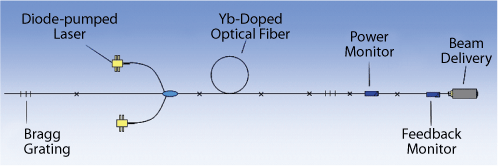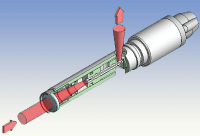- FMA
- The Fabricator
- FABTECH
- Canadian Metalworking
Categories
- Additive Manufacturing
- Aluminum Welding
- Arc Welding
- Assembly and Joining
- Automation and Robotics
- Bending and Forming
- Consumables
- Cutting and Weld Prep
- Electric Vehicles
- En Español
- Finishing
- Hydroforming
- Laser Cutting
- Laser Welding
- Machining
- Manufacturing Software
- Materials Handling
- Metals/Materials
- Oxyfuel Cutting
- Plasma Cutting
- Power Tools
- Punching and Other Holemaking
- Roll Forming
- Safety
- Sawing
- Shearing
- Shop Management
- Testing and Measuring
- Tube and Pipe Fabrication
- Tube and Pipe Production
- Waterjet Cutting
Industry Directory
Webcasts
Podcasts
FAB 40
Advertise
Subscribe
Account Login
Search
Are you getting enough fiber in your metal fabricating diet?
Examining the growing market for fiber lasers
- By Mark Richmond
- August 26, 2008
- Article
- Laser Cutting
This year has been called the year of the fiber laser. Sales for 2008 are forecast to increase by 16 percent, to $323 million overall, with $112 million in sales expected in metal processing industries.
So what's the fuss about?
Fiber Lasers in Metal Processing
Although most of the interest in fiber lasers has been generated from developments over the past few years, they first were invented in the very early days of the laser's history. In 1964 a flashlamp-pumped fiber laser was demonstrated. Around 1990 the double-clad fiber structure enabled a diode-pumped laser to be demonstrated. This was the forerunner of today's fiber laser products.
The use of lasers for metal processing continues to grow, and fiber lasers are taking an increasing share of the market, up from 2 percent in 2003 to 8 percent in 2007. This relatively small market share, however, masks a very large growth in overall sales, which increased by 39 percent in 2007 and are expected to expand another 16 percent in 2008. One report predicts a doubling of fiber laser sales by 2011.
It's interesting to note that the fiber laser is beginning to penetrate the flat sheet metal cutting sector. Although only 50 systems were installed for this application in 2007, this indicates how the fiber laser is penetrating mature laser metal processing applications. Its transition from scientific and low-power telecommunication applications to the metal fabrication arena is real and expected to strengthen in the coming years.
Laser Structure
Figure 1 shows the basic components comprising a laser. The gain medium can produce light when the excitation energy is applied to it. The front and rear mirrors define the resonator and ensure the light reflects back and forth through the gain medium to gain intensity and reduce angular spread. The fraction of the light that passes through the partially transmitting front mirror becomes the useful laser beam.
For a CO2 laser, the gain medium is a mixture of gases—mainly helium, nitrogen, and CO2—and the excitation energy comes from the electrical discharge through the gas. The laser beam wavelength is 10.6 m. For a solid-state laser, the gain medium typically is a rod of yttrium aluminum garnet (YAG) doped with about 1 percent neodymium (Nd) atoms; excitation energy is provided by the broadband light from a pulsed flashlamp or continuous-arc lamp. The laser beam wavelength is 1.064 m.
The gain medium for a fiber laser is an ytterbium-doped glass fiber, with the excitation energy being provided by laser diodes operating around 950 nm and coupled by various schemes into the core of the doped fiber (see Figure 2). The laser beam wavelength typically is in a range of 1.07 m to 1.09 m.
Obviously, the physical dimensions of the gain medium for the fiber laser are very different from other laser types. An Nd:YAG rod might be 200 millimeters long and have a CO2 discharge around 2 meters, but the gain medium in a fiber laser is decameters long.
The reflectors used in the fiber laser also are very different physically from traditional lasers'. Rather than mirrors, the fiber laser uses Bragg gratings written into the core of a fiber. These fiber Bragg gratings (FBGs) consist of periodic refractive index variations. The longitudinal period of the grating determines the wavelength of the reflected light, and the magnitude of the variation controls the reflected percentage. Thus, it is possible to manufacture the complete fiber laser so that the light is contained within fiber components right up to the beam delivery point at the workpiece.
Features
A laser beam's quality is defined by its M2 value, which is determined by wavelength, beam waist radius, and far-field divergence. Lasers with the highest beam quality have an M2 close to 1. This is sometimes referred to as diffraction limited performance, and it is a fundamental physical limit. The long, thin gain media of fiber lasers enables them to produce these high-quality beams, which are commercially available with output powers up to a few kilowatts.
Such beams can be focused to a very small spot on the workpiece, giving very high-power density, which can lead to faster processing. They offer benefits such as a long focal length (working distance) and high depth of focus (workpiece positioning tolerance).
The system can be optimized to achieve the smallest focal-spot diameter, making it possible to process materials in much finer detail than with other lasers.
The high efficiency of the pump source and of extraction from the gain medium produces a wall plug efficiency for the laser of about 25 percent to 30 percent. This leads to reduced electrical and cooling requirements, with air cooling reductions possible up to 300 watts. Some fiber laser products offer 100,000 hours mean time between failures for their laser diode-pumped sources, which equates to 11 years of operation.
The laser has a compact head and power supply and few mechanical components. Routine maintenance requirements are very low. All-fiber construction eliminates the need for alignment of the resonator or beam delivery optics. Contamination of optical surfaces also is eliminated by the sealed beam path within the fiber.
As the light is generated in the fiber, it can easily be delivered to the workpiece within a fiber. This provides a stable setup and removes the issues of having to maintain alignment on a number of beam delivery mirrors and coupling the laser beam into a beam delivery fiber.
Optical Feedback
High-power fiber devices for material processing can be sensitive to optical feedback, which in some cases can lead to damage of the laser components. The effective mode area at the end of the delivery fiber is very small for single-mode beams, so the power density on the fiber ends is extremely high, and the ends can be damaged easily if contamination is present, especially in the presence of back-reflected light.
An optical isolator is used in these situations to prevent back-reflected light from reaching the fiber. Because the high-power fiber laser output usually is unpolarized, at least two high-power Faraday rotators and two polarizers are required.
If for some reason an isolator cannot be used, the laser operator must avoid back-reflections by never allowing the laser beam to be perpendicular to the workpiece surface. Of course, this restricts processing flexibility and possibly quality.
Some fiber lasers are available with an integrated system that protects against back-reflection. The fiber end is shaped so that the beam is allowed to expand in diameter before it exits the silica material of the delivery fiber, greatly reducing the possibility of damage (see Figure 3).
Current and Future Applications
Industrial fiber lasers are used for material processing in low-power and high-power applications. The capability to generate optical power up to the multikilowatt level, and deliver it in a spot less than 10 m in diameter, makes fiber lasers suitable for cutting, welding, scribing, drilling, micromachining, and marking.
For robotic applications in the automotive industry, fiber lasers with output powers from 200 W to multikilowatts help keep capital investments relatively low while providing versatility and redeployment for future use. Cutting of hydroformed tubing and remote welding are near-term applications for fiber lasers of these wattages.
In the aerospace industry, fiber lasers currently are used for laser cladding, trepanning, helical drilling, and multiaxis cutting and welding. In the medical field, fiber lasers can be used to cut stents and to seam-weld pacemakers and implantable batteries. The spot welding of flexures and suspension assemblies, such as read/write heads in computer manufacturing, is being considered, as is welding of pressure transducers.
In the fabricated metal products industry, fiber lasers are being used increasingly for flat sheet cutting. Welding of steel and aluminum plate for the shipbuilding industry is under investigation. Remote welding applications in the pipeline industry, as well as welding and cutting onboard ships, also are being considered.
For cladding, deep-hole drilling, and welding of thick sections, fiber lasers from 8 to 20 kW are projected to make major inroads because of their processing speed and penetration depth capabilities. In the high-power sector, fiber lasers are being used in the automotive industry for tailored blank welding, hydroformed part cutting, and body-in-white welding and remote welding.
The fiber laser is maturing rapidly as a technology for use in all aspects of metal fabrication, from high finesse to thick section, and easily covers typical job shop applications. The key to its further penetration into these markets is for system builders to integrate them with the high level of process parameter knowledge that is found with many of today's CO2 laser-based systems.
About the Author
Mark Richmond
Cosford Lane
Rugby, Warwickshire CV21 1QN United Kingdom
subscribe now

The Fabricator is North America's leading magazine for the metal forming and fabricating industry. The magazine delivers the news, technical articles, and case histories that enable fabricators to do their jobs more efficiently. The Fabricator has served the industry since 1970.
start your free subscription- Stay connected from anywhere

Easily access valuable industry resources now with full access to the digital edition of The Fabricator.

Easily access valuable industry resources now with full access to the digital edition of The Welder.

Easily access valuable industry resources now with full access to the digital edition of The Tube and Pipe Journal.
- Podcasting
- Podcast:
- The Fabricator Podcast
- Published:
- 04/16/2024
- Running Time:
- 63:29
In this episode of The Fabricator Podcast, Caleb Chamberlain, co-founder and CEO of OSH Cut, discusses his company’s...
- Industry Events
16th Annual Safety Conference
- April 30 - May 1, 2024
- Elgin,
Pipe and Tube Conference
- May 21 - 22, 2024
- Omaha, NE
World-Class Roll Forming Workshop
- June 5 - 6, 2024
- Louisville, KY
Advanced Laser Application Workshop
- June 25 - 27, 2024
- Novi, MI



































